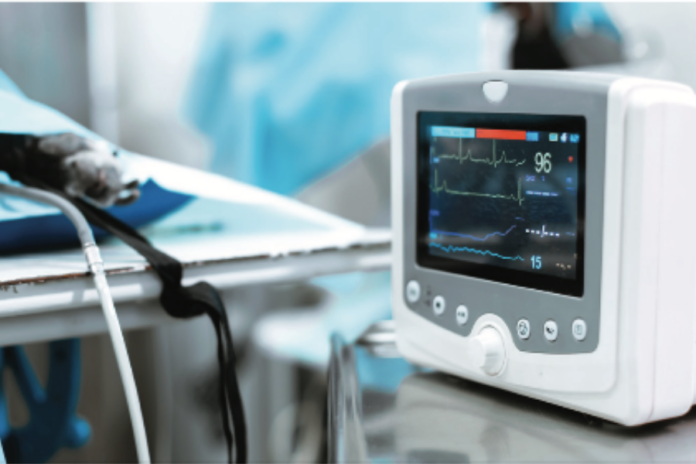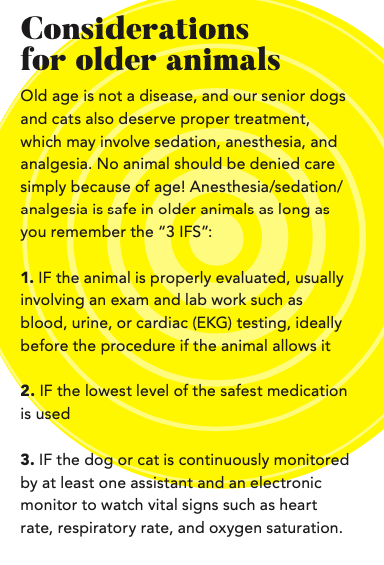Anesthesia, analgesia, or sedation?

What are the differences, and what might your dog or cat need?
Whether your dog or cat is going in for dental work, a spay/neuter op, or some other procedure, he’ll need to be anesthetized or sedated for the duration. An important part of veterinary medicine is the ability to chemically restrain patients, when needed, for both minor procedures as well as more complicated surgical interventions. This is also done to relieve and ideally prevent pain. However, many people fear having their animals “put under”, likely because they don’t fully understand the medications being used. From anesthesia to analgesia to sedation, this article presents an overview of some of the methods veterinarians use to immobilize their patients and make procedures safer for the staff as well as the animals.
ANESTHESIA
General anesthesia renders the patient unconscious. In other words, the animal is asleep and unaware of anything being done to him. Anesthesia does not prevent pain, so once the dog or cat awakens, she can and will feel pain unless analgesics are also administered (more on these later). General anesthesia is given at various levels, from light to deep.
• Light anesthesia is suitable for procedures such as dental cleanings and the removal of small warts or tumors.
 • Deeper levels of anesthesia are needed as the perceived pain associated with the procedure increases, and when the veterinary team does not want the animal to move. Deeper general anesthesia is used for common surgical procedures such as a spay or neuter, removing bladder stones, abdominal biopsies, and orthopedic procedures.
• Deeper levels of anesthesia are needed as the perceived pain associated with the procedure increases, and when the veterinary team does not want the animal to move. Deeper general anesthesia is used for common surgical procedures such as a spay or neuter, removing bladder stones, abdominal biopsies, and orthopedic procedures.
A general goal of anesthesia is to take the patient to a level that’s deep enough to achieve the aim of the procedure, while at the same time keeping it light enough to maintain stable vital signs. When people have concerns about the safety of anesthesia, it often makes them hesitant or fearful about consenting to procedures. While modern anesthetics are very safe compared to the “old days,” no procedure is without risk. While exceptionally rare, both people and animals, young and old, healthy and unhealthy, can die under anesthesia. In order to minimize the risk of death or other anesthetic complications, the following guidelines should be kept in mind:
- For elective procedures, the dog or cat should be metabolically stable and as healthy as possible. The relevant diseases or other conditions should ideally be cured or at least stabilized by the procedure, rendering them insignificant as far as any anesthetic risk is concerned.
- Preoperative evaluations should be performed in most animals. The correct anesthetic is administered at the correct dosage for the dog or cat’s weight, age, and health. Only the amount of anesthetic needed for the procedure is used.
- The patient must be carefully monitored both during and after 3 the procedure, by both a live person (veterinary assistant or technician) and by electronic monitoring equipment (typically an EKG and pulse oximetry at minimum). To reduce the amount of general anesthesia needed, a preanesthetic sedative is usually given 15 to 30 minutes prior to the procedure (some sedatives can be reversed upon completion of the anesthesia, when desired).
DID YOU KNOW? General anesthesia can be given intravenously or by endotracheal tube or mask (for gas anesthesia). Usually, gas anesthesia is preferred for longer procedures, while either gas or IV anesthesia can be used for shorter procedures.
Local anesthesia is injectable anesthesia (usually with lidocaine or similar medication) given locally at the site of tissue injury. Most commonly, this is the site of the surgical incision, or the site of a cut or injury to the skin and soft tissue. Local anesthesia can be combined with sedation or used on its own, as in the case of removing a small lesion such as a wart in a very calm or older animals (more active dogs and cats typically require sedation plus a local anesthetic for minor lesion removal). Using local anesthesia minimizes the level of sedation needed.
DID YOU KNOW? Local anesthesia, unlike general anesthesia, is analgesic and relieves pain for several hours following administration. Because local anesthesia is temporary, however, an analgesic medication is typically also used to prevent pain when the local anesthetic wears off.
Regional anesthesia is a special form of local anesthesia, in which a certain part of the body, such as a paw or the pelvis, is anesthetized. Another example is the use of a selected nerve block, often utilized for dental procedures such as extractions.
SEDATION
For many minor procedures, the animal does not need to be completely immobile or unconscious. In these instances, simple sedation is adequate and preferred. Sedation involves administering a medication, usually intravenously or subcutaneously (under the skin) to cause the dog or cat to relax and become very easy to handle. In my practice, procedures for which we use sedation include:
- Radiography
- The removal of small, superficial tumors and skin lesions
- Skin biopsy procedures
- IV catheterization (in some patients)
- Drawing blood in fractious or aggressive animals
- Enemas
- Splint/bandage changes
- Urinary catheterization procedures.
Remember that sedated animals are not totally asleep but only relaxed; depending upon the medications used, the sedation can be quickly reversed upon completion of the procedure and the dog or cat will be fully awake and ready for the trip home shortly after the procedure (a benefit over general anesthesia, which requires a longer recovery time).
ANALGESIA
Analgesics are given to relieve (and ideally prevent) pain — in fact “analgesia” means “without pain”. These mediations are useful in a variety of situations, including trauma, surgery, and medical problems such as arthritis and cancer. Basically, any time pain occurs or is expected to occur, analgesics are a must.
In general, there are two broad classes of analgesics: opioid (and similar) medications and NSAIDS (non-steroidals). Occasionally, steroids such as prednisone may relieve pain but are typically not selected in most cases due to side effects and the fact that the other two types of analgesics provide stronger pain relief.
Animals that may need long-term analgesia for pain relief from chronic diseases should undergo frequent examination as well as blood and urine testing (every three to six months, especially in older animals, and depending on the condition) to allow for early diagnosis of any side effects such as GI irritation or kidney or liver problems. Animals that already have these problems can usually use these medications safely, but the dosage may need to be lowered to minimize side effects.
 DID YOU KNOW? Once stable, dogs and cats can often have their analgesics decreased or stopped if natural therapies are also utilized.
DID YOU KNOW? Once stable, dogs and cats can often have their analgesics decreased or stopped if natural therapies are also utilized.
Anesthesia, sedation, and analgesia are common-employed techniques in veterinary medicine. They are very safe if used correctly, and most animals do not experience side effects. I always recommend that you chat with
your veterinarian prior to any procedure to know which medications are selected and why, as well as their side effects. Finally. remember that even when general anesthesia is used, your animal should go home fully awake unless mild sedation is needed. No dog or cat should go home half-awake or “drunk”. In my practice, patients awaken within minutes of a procedure, and are as awake and alert as when they first entered the hospital.



